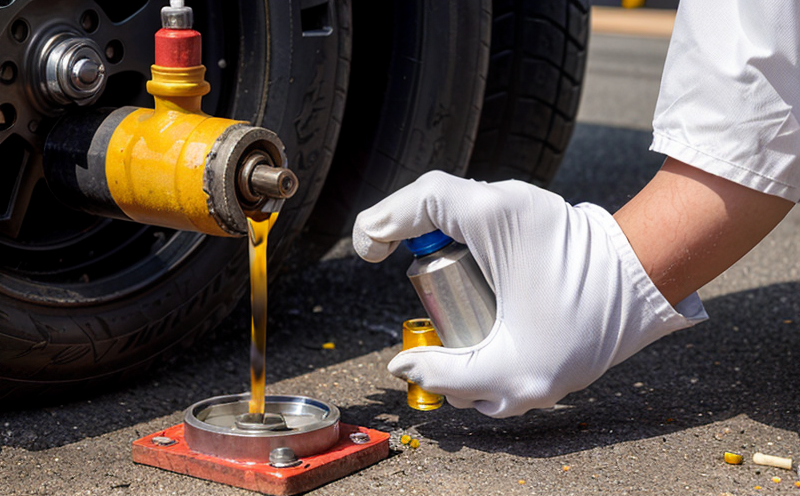ASTM D5185 Elemental Analysis of Lubricating Oils by ICP
The ASTM D5185 standard method is a critical tool in the analysis of elemental content within lubricating oils. This test measures trace amounts of various metallic elements present in used and new lubricants, providing insights into wear debris, contamination sources, and overall oil condition. Elemental analysis by Inductively Coupled Plasma (ICP) spectrometry is widely recognized for its precision and sensitivity, making it an indispensable tool in the maintenance and quality control of marine equipment.
For sectors such as maritime transportation, elemental analysis ensures that critical components like engines, transmissions, and bearings are operating within optimal conditions. By identifying wear particles and contaminants early on, this test helps prevent costly downtime and potential catastrophic failures. Additionally, it supports compliance with international regulations related to environmental protection and operational efficiency.
The ASTM D5185 standard specifies the procedure for determining trace amounts of metallic elements in used lubricating oils using ICP spectrometry. Key metals analyzed include iron (Fe), copper (Cu), chromium (Cr), nickel (Ni), molybdenum (Mo), and others that contribute to wear or indicate contamination levels. This information is crucial for quality managers, compliance officers, R&D engineers, and procurement specialists responsible for maintaining the integrity of marine equipment.
Preparation steps before testing are essential to ensure accurate results. Samples must be thoroughly cleaned from any non-lubricant residues using appropriate solvents. The sample should then be diluted with deionized water or an approved solvent, ensuring that it adheres strictly to the dilution ratio specified in the ASTM D5185 standard.
The testing process itself involves introducing the sample into the ICP instrument. As the sample is atomized and excited by a high-frequency radio wave, elemental emissions are detected and measured. The results provide quantitative data on the concentration of each element present, allowing for comparison against baseline values or established limits.
Understanding the implications of these findings can significantly impact decision-making processes within organizations. For instance, elevated copper levels might suggest issues with seals or bearings; increased iron content could indicate abrasive wear in gears or pistons. Armed with this knowledge, maintenance teams can proactively address problems before they escalate into major repairs.
Let's delve deeper into the scope and methodology of ASTM D5185 elemental analysis:
| Scope | This method covers the determination of trace amounts (typically 0.1 µg/mL to 1 mg/mL) of metallic elements in used lubricating oils. |
|---|---|
| Methodology | The procedure uses Inductively Coupled Plasma Optical Emission Spectrometry (ICP-OES). It involves sample preparation, dilution, introduction into the ICP instrument for atomization and excitation, followed by detection of elemental emissions. |
The precision and accuracy achieved through this method make it suitable not only for routine monitoring but also for research purposes where small variations in element concentrations can be significant. Regular analysis allows operators to track trends over time, ensuring that their equipment remains at peak performance levels while minimizing unnecessary maintenance or replacement costs.
Why It Matters
The importance of ASTM D5185 elemental analysis cannot be overstated, especially within the context of marine and ship equipment testing. By identifying wear particles and contaminants early on, this test helps prevent costly downtime and potential catastrophic failures. Moreover, it supports compliance with international regulations related to environmental protection and operational efficiency.
For quality managers, compliance officers, R&D engineers, and procurement specialists responsible for maintaining the integrity of marine equipment, understanding the implications of these findings can significantly impact decision-making processes within organizations. For instance, elevated copper levels might suggest issues with seals or bearings; increased iron content could indicate abrasive wear in gears or pistons.
Regular analysis allows operators to track trends over time, ensuring that their equipment remains at peak performance levels while minimizing unnecessary maintenance or replacement costs. This proactive approach not only enhances operational reliability but also contributes positively towards sustainability goals by optimizing resource use and reducing waste generation.
Scope and Methodology
| Scope | This method covers the determination of trace amounts (typically 0.1 µg/mL to 1 mg/mL) of metallic elements in used lubricating oils. |
|---|---|
| Methodology | The procedure uses Inductively Coupled Plasma Optical Emission Spectrometry (ICP-OES). It involves sample preparation, dilution, introduction into the ICP instrument for atomization and excitation, followed by detection of elemental emissions. |
ASTM D5185 specifies detailed procedures to ensure consistent results across different laboratories. These include precise sample collection techniques, standardized dilution ratios, and stringent quality control measures during testing. The method also allows for calibration checks at regular intervals to maintain instrument accuracy over time.
Use Cases and Application Examples
- Detecting wear particles from gears, bearings, or other moving parts in marine engines.
- Identifying sources of contamination such as foreign materials introduced during refueling operations.
- Evaluating the effectiveness of maintenance practices by comparing current results with historical data.
- Assisting in troubleshooting persistent performance issues by pinpointing specific elements responsible for degradation.
- Supporting compliance audits conducted by regulatory bodies enforcing environmental standards.
These real-world applications underscore why ASTM D5185 elemental analysis is considered a cornerstone of lubricant testing within the marine industry. Its ability to provide precise, reliable data enables informed decisions regarding equipment maintenance and operational strategies.





